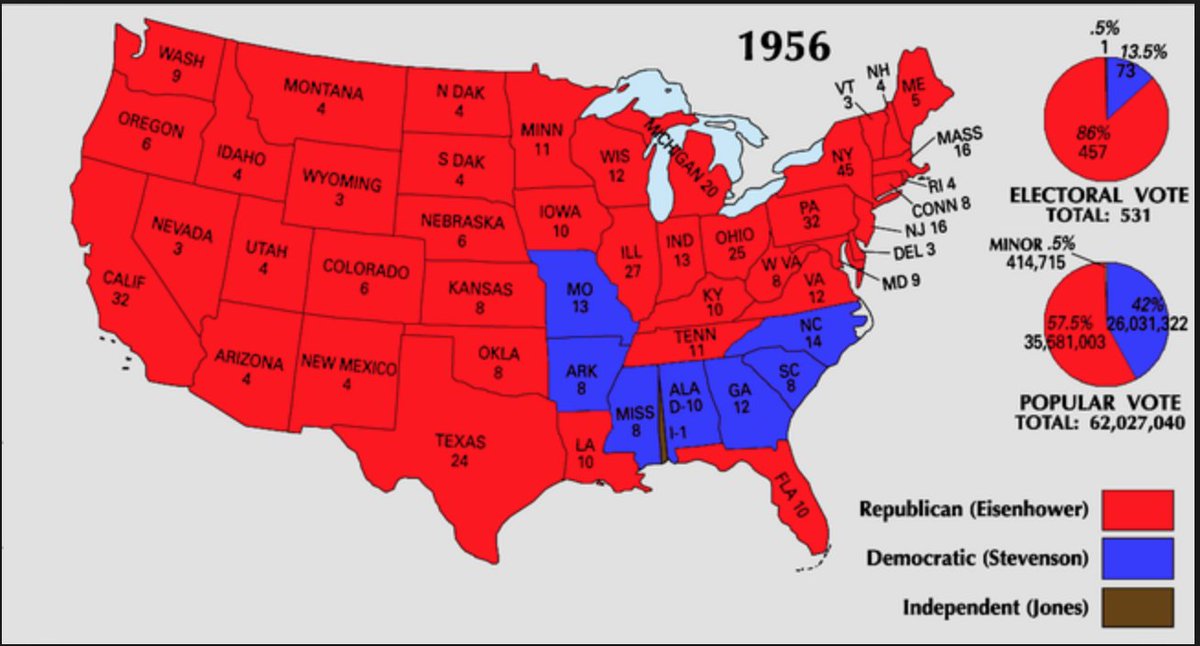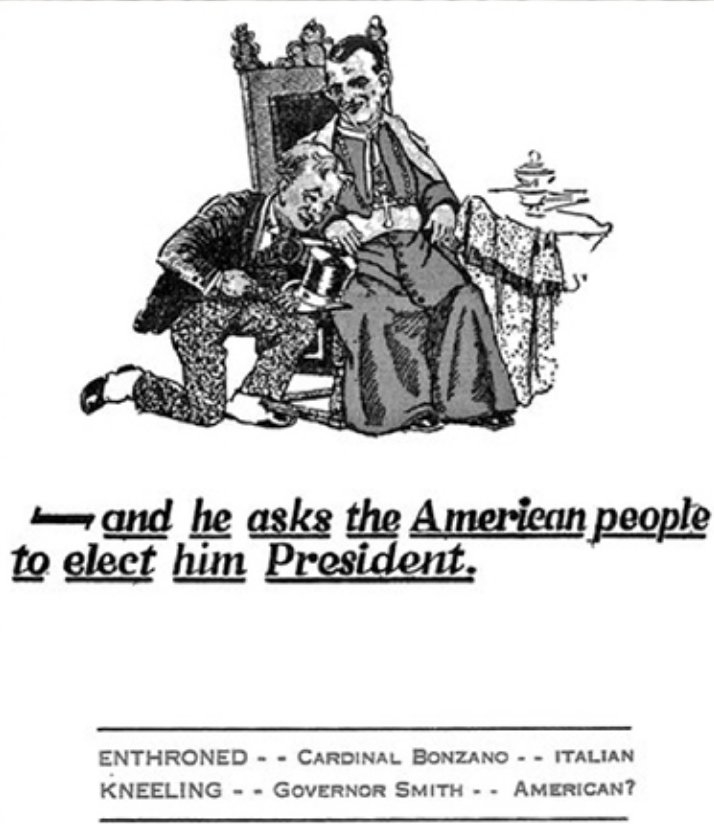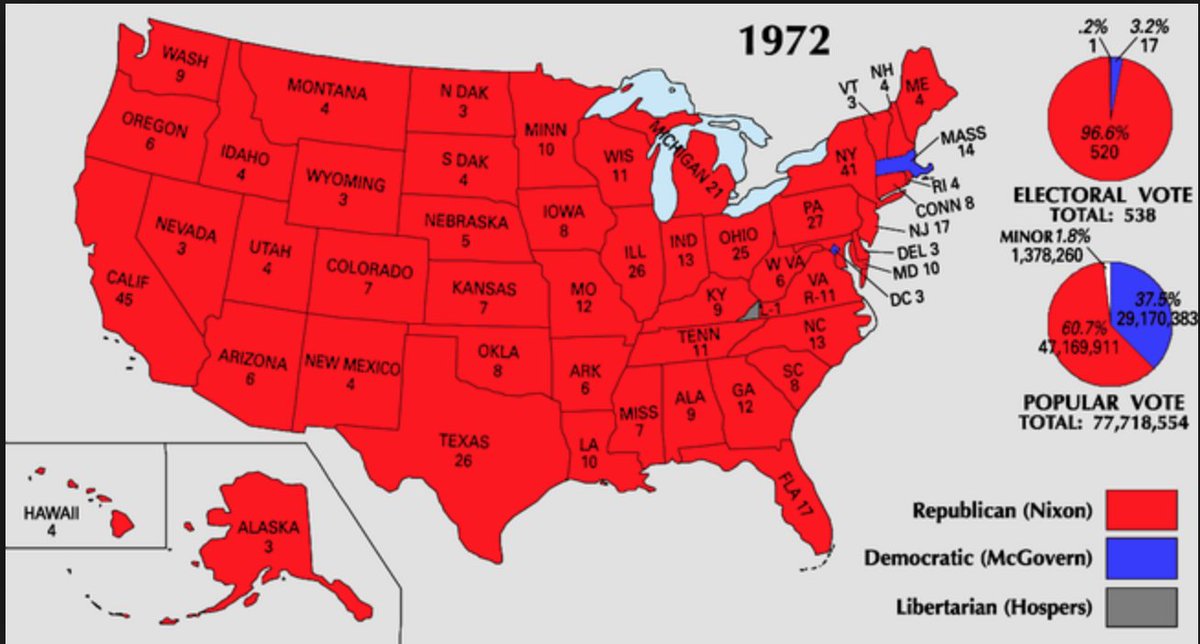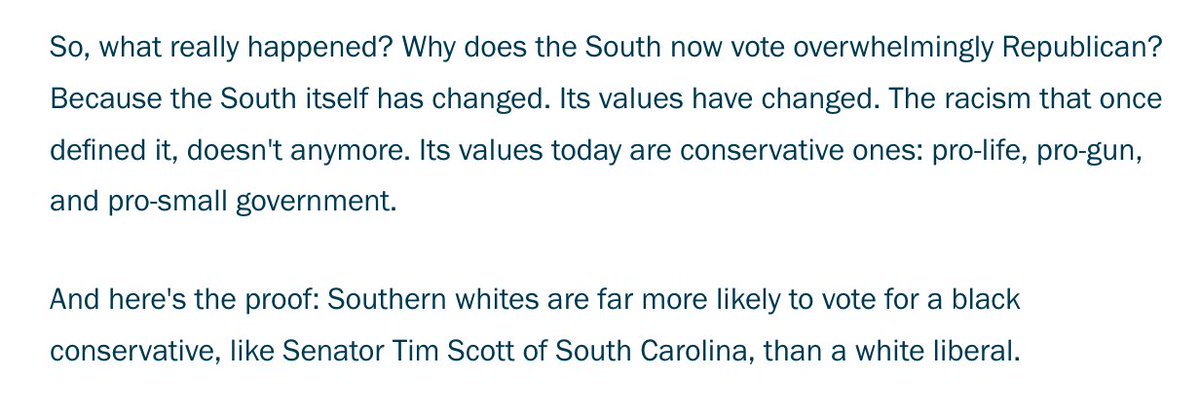I& #39;d really rather stop talking about this, but the video at this link has nearly 10 million views now, so ... buckle up. https://twitter.com/prageru/status/996165540161830912">https://twitter.com/prageru/s...
Here& #39;s the link to the full video -- just five and a half minutes -- and a transcript. https://www.prageru.com/videos/why-did-democratic-south-become-republican">https://www.prageru.com/videos/wh...
This is the basic argument: Long after the Democrats lost the South, a conspiracy of liberal academics and journalists cooked up a theory that didn& #39;t reflect what was happening at the time.
For starters, the idea that the "southern strategy" was invented after the fact is deeply ahistorical.
There was considerable discussion of it throughout the 1960s, especially within the ranks of the Republican Party, as I detailed here: https://twitter.com/KevinMKruse/status/993475124618825728">https://twitter.com/KevinMKru...
There was considerable discussion of it throughout the 1960s, especially within the ranks of the Republican Party, as I detailed here: https://twitter.com/KevinMKruse/status/993475124618825728">https://twitter.com/KevinMKru...
The video claims this was a conspiracy concocted later by academics, and names three central myths in this conspiracy -- ones that aren& #39;t actually central to the actual scholarship on party realignment, but are imputed to unnamed "left-leaning academic elites." OK, let& #39;s dig in.
Here& #39;s Myth #1.
All of these points are true, and no historian would disagree with any of them.
Well, except for the claim that the Little Rock crisis of 1957 somehow happened *before* the presidential election of 1956. I& #39;m pretty sure we& #39;d all challenge that claim.
All of these points are true, and no historian would disagree with any of them.
Well, except for the claim that the Little Rock crisis of 1957 somehow happened *before* the presidential election of 1956. I& #39;m pretty sure we& #39;d all challenge that claim.
But those points are outliers in the larger scheme, cherry-picked points that have been blown out of proportion.
In each of those elections, the GOP candidate *did* crack the Solid South. But those were landslide elections where the South and only the South stood by the Dems.
In each of those elections, the GOP candidate *did* crack the Solid South. But those were landslide elections where the South and only the South stood by the Dems.
Furthermore, each of those elections had its own unique dynamic.
Hoover cracked the South not just because he was nationally popular, but because his opponent -- Al Smith, an Irish Catholic New Yorker who opposed Prohibition -- was reviled in the South and opposed by the Klan.
Hoover cracked the South not just because he was nationally popular, but because his opponent -- Al Smith, an Irish Catholic New Yorker who opposed Prohibition -- was reviled in the South and opposed by the Klan.
The video implies Hoover& #39;s freak win was the start of something new -- "as early as 1928" -- but it had no ripple effects.
Throughout the 1930s and 1940s, the GOP made no further inroads in the South -- not in races for president, Senate, House, governor, etc. Nothing.
Throughout the 1930s and 1940s, the GOP made no further inroads in the South -- not in races for president, Senate, House, governor, etc. Nothing.
As I noted in this thread, the first real cracks in the "Solid South" came in 1948 when Truman committed the national party to civil rights and the Dixiecrats under Strom Thurmond tried to bolt. https://twitter.com/KevinMKruse/status/991131192236888064">https://twitter.com/KevinMKru...
Eisenhower benefited from the backlash to the national Democrats& #39; shift in the next election -- though again, much of his success was due to his personal popularity in the South. He too was an outlier. https://twitter.com/KevinMKruse/status/991131203376992256">https://twitter.com/KevinMKru...
And again, despite the video& #39;s claims here, the 1956 presidential election did *not* in fact come after Eisenhower sent the 101st Airborne to Little Rock.
That was in 1957. 1957 came after 1956.
That was in 1957. 1957 came after 1956.
All right, Myth #2.
Again, every historian (even liberal-leaning academic elites!) would agree with this fact.
Though they& #39;d point out that this one unnamed senator was a fairly significant one -- Strom Thurmond, the outspoken segregationist who led the 1948 Dixiecrat revolt.
Again, every historian (even liberal-leaning academic elites!) would agree with this fact.
Though they& #39;d point out that this one unnamed senator was a fairly significant one -- Strom Thurmond, the outspoken segregationist who led the 1948 Dixiecrat revolt.
But yes! Thurmond was the only Southern Democratic senator to switch parties.
Because that& #39;s not how the party realignment took place. Senators in this era held power through seniority and, despite efforts to replicate Thurmond& #39;s deal, it was a one-off. https://twitter.com/KevinMKruse/status/992842365953085442">https://twitter.com/KevinMKru...
Because that& #39;s not how the party realignment took place. Senators in this era held power through seniority and, despite efforts to replicate Thurmond& #39;s deal, it was a one-off. https://twitter.com/KevinMKruse/status/992842365953085442">https://twitter.com/KevinMKru...
If we move beyond the intentionally narrow terms of the video, to look at more than just the 20 senior Dixiecrats in the Senate who remained Democrats and consider the larger transformation in party loyalties of white southern conservatives, we can see the larger shift unfold.
Look at the House. Here, too, most (but not all) Dixiecrats stayed put!
But notably, they encouraged the younger generation to replace them by running as Republicans.
The career of former Senate Majority Leader Trent Lott (R-MS) is a good example: https://twitter.com/KevinMKruse/status/991137736341032961">https://twitter.com/KevinMKru...
But notably, they encouraged the younger generation to replace them by running as Republicans.
The career of former Senate Majority Leader Trent Lott (R-MS) is a good example: https://twitter.com/KevinMKruse/status/991137736341032961">https://twitter.com/KevinMKru...
This was part of a larger trend, as the first wave of Southern GOP House members were former Democrats who switched parties and ran as Republicans -- without changing their old stance on race and civil rights.
I detailed it at length here: https://twitter.com/KevinMKruse/status/993475118058926080">https://twitter.com/KevinMKru...
I detailed it at length here: https://twitter.com/KevinMKruse/status/993475118058926080">https://twitter.com/KevinMKru...
Change in Congress came slowly, as old Dixiecrats retired or were replaced by white conservative Republicans who were indistinguishable from them on civil rights issues -- seat by seat, decade by decade.
This has been chronicled in extensive detail. https://www.amazon.com/Rise-Southern-Republicans-Earl-Black/dp/0674012488">https://www.amazon.com/Rise-Sout...
This has been chronicled in extensive detail. https://www.amazon.com/Rise-Southern-Republicans-Earl-Black/dp/0674012488">https://www.amazon.com/Rise-Sout...
If we look beyond Congress, moreover, we can see a broader transformation in statewide offices, from governor on down.
Here are a few examples of that: https://twitter.com/KevinMKruse/status/992842385343287301">https://twitter.com/KevinMKru...
Here are a few examples of that: https://twitter.com/KevinMKruse/status/992842385343287301">https://twitter.com/KevinMKru...
Individual careers changed course slowly, though, and in piecemeal fashion.
The idea that the region& #39;s representatives switched parties at the same time is a straw man.
What did change were public perceptions of the parties on matters of civil rights, as @edsall noted here.
The idea that the region& #39;s representatives switched parties at the same time is a straw man.
What did change were public perceptions of the parties on matters of civil rights, as @edsall noted here.
Again, as that polling data chronicles -- and moreover, as the movement of black voters showed -- this shift in the parties& #39; stances on civil rights was well understood by ordinary Americans as it happened.
This wasn& #39;t some conspiracy cooked up by "academic elites" later on.
This wasn& #39;t some conspiracy cooked up by "academic elites" later on.
OK, moving on to Myth #3.
Again, we& #39;ve got an odd combination of misstatements and cherry-picked facts.
Again, we& #39;ve got an odd combination of misstatements and cherry-picked facts.
No, Nixon didn& #39;t win the Deep South in 1968! But neither did the Democratic candidate that year.
Segregationist George Wallace, who& #39;d run as an independent (after flirting with a switch to the GOP in 1964), won the Deep South.
And oh, Nixon won it all the next time around.
Segregationist George Wallace, who& #39;d run as an independent (after flirting with a switch to the GOP in 1964), won the Deep South.
And oh, Nixon won it all the next time around.
Yes, Carter (GA) and Clinton/Gore (AR/TN) made inroads in the South in 1976 and 1992 & 1996.
Southerners won some of the South! Right!
This is only a "gotcha" if you think the realignment story is one where everything changed overnight in 1964. Again, no academic argues that.
Southerners won some of the South! Right!
This is only a "gotcha" if you think the realignment story is one where everything changed overnight in 1964. Again, no academic argues that.
You can ultimately tell how weak this argument is by the final point.
Sorry, no -- the two elections of Senator Tim Scott (in 2014 and 2016) doesn& #39;t retroactively change how things unfolded fifty years before in the South.
That& #39;s not how history works.
Sorry, no -- the two elections of Senator Tim Scott (in 2014 and 2016) doesn& #39;t retroactively change how things unfolded fifty years before in the South.
That& #39;s not how history works.
Sorry to clog your timeline yet again with a rebuttal to this nonsense, but as that video has nearly ten million views, it seemed worth a little response.
I& #39;m sure other #Twitterstorians and political scientists who know the literature will chime in with other points too.
I& #39;m sure other #Twitterstorians and political scientists who know the literature will chime in with other points too.
But before I get to my actual job, let me just repeat one small point.
The federal intervention in Little Rock happened in 1957.
And, despite what this video says, the year 1957 came *after* the 1956 presidential election. Honestly.
The federal intervention in Little Rock happened in 1957.
And, despite what this video says, the year 1957 came *after* the 1956 presidential election. Honestly.
As a P.S., here& #39;s Carol Swain -- the star of the video -- describing the southern strategy in her own book: https://twitter.com/kevinmkruse/status/996530512981364736">https://twitter.com/kevinmkru...

 Read on Twitter
Read on Twitter
















